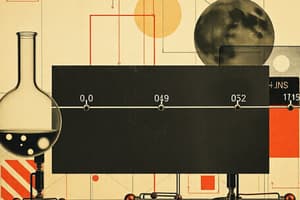Podcast
Questions and Answers
What does a small equilibrium constant (K) indicate?
What does a small equilibrium constant (K) indicate?
- Reaction is at equilibrium
- Reactants dominate (correct)
- Products dominate
- Reaction goes to completion
What does K > 102 indicate about a reaction?
What does K > 102 indicate about a reaction?
- Reactants dominate
- Products dominate (correct)
- Reaction is at equilibrium
- Reaction hardly proceeds
What can be concluded if K < 10^-3?
What can be concluded if K < 10^-3?
- Neither reactants nor products are significant
- Reactants dominate (correct)
- Products dominate
- Reaction is at equilibrium
What does Q > K imply about the reaction?
What does Q > K imply about the reaction?
What happens to the equilibrium constant when a reaction is multiplied by n?
What happens to the equilibrium constant when a reaction is multiplied by n?
The equilibrium constant Kc is the reciprocal of K'c.
The equilibrium constant Kc is the reciprocal of K'c.
What does Le Chatelier's principle describe?
What does Le Chatelier's principle describe?
Which type of collision involves the conservation of kinetic energy?
Which type of collision involves the conservation of kinetic energy?
The coefficient of restitution (e) is defined as the ratio of the relative velocity of ______ to the relative velocity of ______ of the two colliding bodies.
The coefficient of restitution (e) is defined as the ratio of the relative velocity of ______ to the relative velocity of ______ of the two colliding bodies.
Flashcards are hidden until you start studying
Study Notes
Equilibrium Constant (K)
-
The equilibrium constant (K) is a unitless value used to calculate the extent of a reaction's conversion from reactants to products at equilibrium.
-
Kp and Kc are equilibrium constants for partial pressures and molar concentrations, respectively.
-
If np > nr, then Δn is positive, and Kp > Kc.
-
For example, the reaction PCl5(g) ⇌ PCl3(g) + Cl2(g)
- Δn = 2 - 1 = 1
- Kp > Kc
-
A larger K value indicates a greater extent to which reactants are converted into products.
- If K is small, the equilibrium favors the reactants.
- If K is large, the products dominate.
Reaction Quotient (Q)
- Q is calculated using the same expression as the equilibrium constant but can be calculated at any point during the reaction.
- If Q > K, the net reaction proceeds in the backward direction toward the reactants.
- If Q < K, the net reaction proceeds in the forward direction toward the products.
- If Q = K, the reaction is at equilibrium.
Relationships Between Equilibrium Constants
- K'c = 1/Kc
- K'c = (Kc)n
- K'c = √(Kc)
- K = K1 x K2
Le Chatelier's Principle
- Le Chatelier's principle states that a system at equilibrium will shift to counteract any changes in conditions.
- These changes can include changes in concentration, pressure, or temperature.
e-TECHNO
- In a perfectly elastic collision, the total kinetic energy is conserved before and after the collision.
- The coefficient of restitution (e) measures the elasticity of a collision.
- e = (v2 - v1) / (u1 - u2)
- where v1 and v2 are the final velocities and u1 and u2 are the initial velocities of the colliding bodies.
- The value of e ranges from 0 to 1.
Trigonometric Ratios and Quadrants
- Sine, cosine, tangent, cotangent, secant, and cosecant are the trigonometric ratios used in trigonometry.
- The sign of trigonometric ratios changes depending on the quadrant (1 to 4) of the unit circle.
- The line of sight is the line drawn from the observer's eye to a point on an object.
- The angle of elevation is the angle between the horizontal and the line of sight when the object is above the horizontal level.
- The angle of depression is the angle between the horizontal and the line of sight when the object is below the horizontal level.
Studying That Suits You
Use AI to generate personalized quizzes and flashcards to suit your learning preferences.




